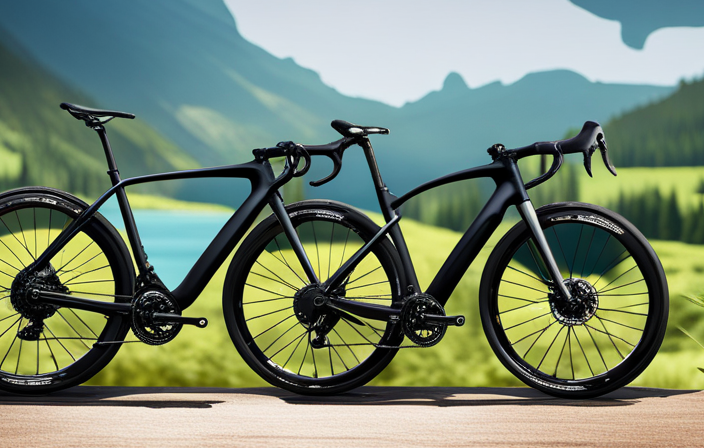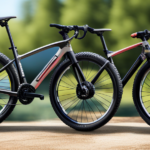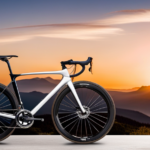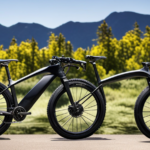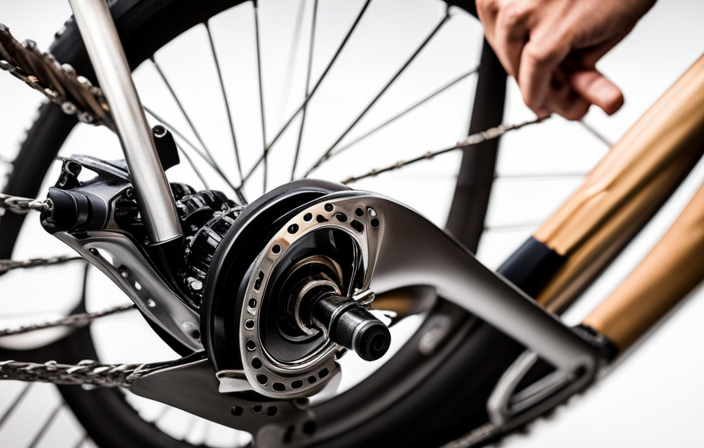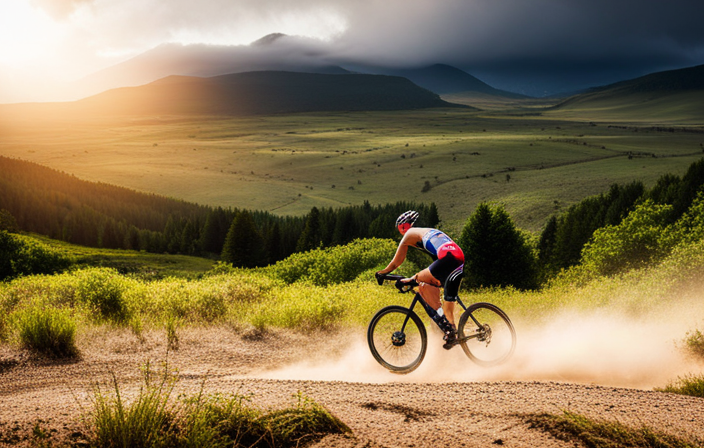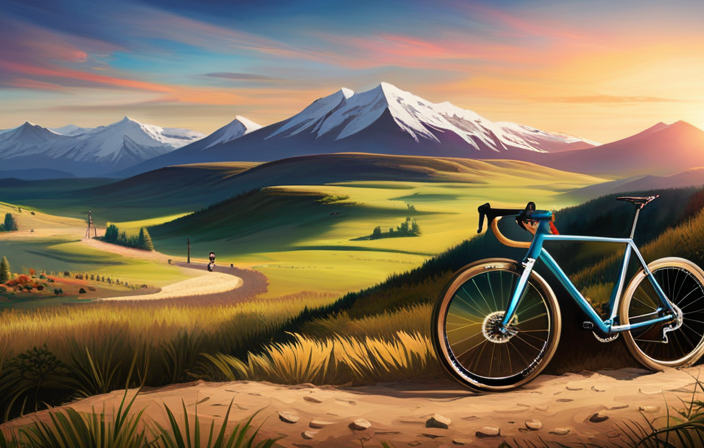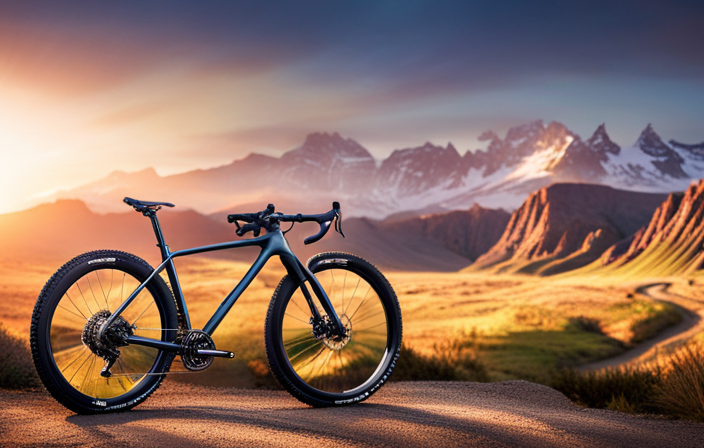Were you aware that, on average, gravel bikes have a speed that is 2 to 4 mph less than that of road bikes?
As a gravel bike enthusiast, I have always been curious about the impact of tire size, bike geometry, and other factors on speed.
In this article, we will delve into the technical aspects behind the slower pace of gravel biking. By exploring various elements such as weight, suspension systems, and terrain influence, we aim to provide a comprehensive understanding of just how much slower a gravel bike can be.
Key Takeaways
- Gravel tires with lower pressure and aggressive tread patterns increase rolling resistance and drag on smooth surfaces, making a gravel bike slower on paved roads.
- The relaxed geometry of gravel bikes sacrifices aerodynamic efficiency, while larger wheels and wider tire clearance improve traction but create more rolling resistance on smooth pavement.
- The weight of a gravel bike affects its performance, with lighter bikes allowing for quicker acceleration and higher speeds with less effort. Climbing uphill with a heavy gravel bike is challenging due to increased gravity resistance.
- Suspension systems on gravel bikes absorb impact and maintain traction on rough terrain, but they add weight and can affect speed on smoother surfaces or climbs. Finding the balance between suspension efficiency and weight is crucial for speed.
The Differences in Tire Size and Type
A gravel bike is slower than a road bike due to the differences in tire size and type. One of the main factors affecting speed is tire pressure and rolling resistance. Gravel tires usually have lower pressure compared to road tires, which allows them to absorb bumps and provide better traction on loose surfaces. However, this also increases rolling resistance, making it harder for the bike to maintain high speeds.
Another important aspect is tire tread and traction. Gravel tires have a more aggressive tread pattern with larger knobs that help grip rough terrain. While this enhances control and stability off-road, it also creates more drag on smooth surfaces like asphalt or concrete. This additional friction slows down the bike when compared to slick road tires with minimal tread.
These differences in tire size, pressure, and tread contribute to the overall slower performance of a gravel bike compared to a road bike on paved roads. However, these trade-offs are necessary for superior handling and durability when riding off-road.
Moving forward into discussing the impact of bike geometry on speed…
The Impact of Bike Geometry on Speed
To gauge the effect of bike geometry on your speed, you’ll notice a noticeable difference when riding a gravel bike compared to other types. The design of the bike frame and the size of the wheels play significant roles in determining how fast you can go.
Bike frame design: Gravel bikes are designed with a more relaxed geometry, featuring a longer wheelbase and slacker head tube angle. This provides stability and comfort over rough terrain but sacrifices some aerodynamic efficiency compared to road bikes.
Bike wheel size: Gravel bikes typically have larger wheels, usually 700c or 650b, which allow for better rolling over uneven surfaces. However, these bigger wheels also increase rotational mass and can be slightly slower to accelerate compared to smaller road bike wheels.
Tire clearance: Another factor influenced by bike geometry is tire clearance. Gravel bikes tend to have wider tire clearances, allowing riders to use larger volume tires that provide better traction and comfort on loose surfaces. However, wider tires can create more rolling resistance on smooth pavement, making them slightly slower than narrower road tires.
Handlebar choice: Gravel bikes often come equipped with flared drop handlebars that offer multiple hand positions for long rides off-road. While these handlebars enhance control during technical sections, they may not be as aerodynamic as traditional road handlebars.
Considering all these factors related to bike geometry, it’s important to understand how they affect your speed on different terrains.
Now let’s transition into discussing the effect of weight on performance without skipping a beat.
The Effect of Weight on Performance
You’ll notice a significant impact on your performance based on the weight of your equipment. When it comes to cycling, weight plays a crucial role in determining how fast you can go. A lighter bike allows you to accelerate quickly and maintain higher speeds with less effort. On the other hand, a heavier bike requires more energy to pedal and may slow you down.
In addition to the weight of the bike itself, factors like elevation and temperature also affect your performance. Climbing uphill with a heavy gravel bike can be challenging as gravity works against you. The extra weight makes it harder to overcome the incline and maintain speed. Similarly, high temperatures can negatively impact your performance by increasing fatigue and reducing overall efficiency.
To optimize your speed on a gravel bike, it’s important to consider these factors when choosing equipment. Look for lightweight components and materials that will help reduce overall weight without sacrificing durability or functionality. Additionally, be mindful of weather conditions and adjust your effort accordingly.
Transitioning into the next section about ‘the role of suspension systems in speed,’ it’s important to note that not only does weight affect performance but so does bike design.
The Role of Suspension Systems in Speed
The role of suspension systems in speed is crucial for maintaining control and stability on rough terrain. Suspension efficiency plays a significant role in determining how well a gravel bike performs in challenging conditions. A good suspension system absorbs the impact from bumps and obstacles, allowing the wheels to maintain contact with the ground and providing better traction. This not only improves comfort but also allows for more efficient power transfer.
When riding over rough terrain, an unsuspended bike can lose traction as it bounces around, causing energy loss and reduced efficiency. On the other hand, a properly designed suspension system helps to keep the tires in contact with the ground, maximizing power transfer to propel the bike forward. It effectively minimizes energy losses by absorbing impacts and reducing vibrations.
However, it’s important to note that suspension systems add weight to the bike, which can slightly affect overall speed on smoother surfaces or during climbs. The additional weight requires more effort from the rider to accelerate and maintain momentum. Therefore, finding a balance between suspension efficiency and weight becomes essential when considering speed.
In conclusion, a well-designed suspension system is crucial for maintaining control and stability on rough terrain while still ensuring efficient power transfer. The impact of suspension systems on speed should be considered alongside factors such as terrain when evaluating gravel bike performance without sacrificing comfort or maneuverability.
The Influence of Terrain on Speed
Riding on rough terrain can greatly impact your speed and overall performance. When it comes to gravel biking, the influence of terrain cannot be ignored. Different types of terrain, such as rocky trails or muddy paths, can significantly slow you down and make it more challenging to maintain a consistent speed.
The influence of weather conditions also plays a role in determining your speed on rough terrains. Rainy or snowy weather can make the surface slippery, making it harder to pedal and control your bike. On the other hand, dry weather conditions may allow for better traction and faster speeds.
Furthermore, the impact of bike maintenance on speed should not be underestimated. A well-maintained gravel bike with properly inflated tires and a clean drivetrain will perform better than one that is neglected. Regularly checking and adjusting components like brakes and gears can ensure optimal performance, allowing you to ride at higher speeds.
Overall, understanding how different terrains affect your speed is crucial for gravel bikers. By considering weather conditions and maintaining your bike properly, you can maximize your performance on rough surfaces.
Now let’s explore how wind resistance affects speed without compromising stability while riding off-road.
How Wind Resistance Affects Speed
In the previous section, we discussed how different terrains can affect the speed of a gravel bike. Now, let’s dive into another important factor that affects speed: wind resistance. When riding a bike, especially at higher speeds, wind resistance plays a significant role in determining how fast you can go.
Wind resistance is the force that opposes the motion of an object through the air. The faster you ride, the greater the wind resistance becomes. This means that when you’re riding against a headwind, you’ll need to exert more energy to maintain your speed compared to riding with a tailwind. Additionally, crosswinds can also have an impact on your stability and efficiency.
To give you a better understanding of how wind resistance affects speed, let’s take a look at this table:
| Wind Speed (mph) | Increase in Power Required (%) | Decrease in Speed (%) |
|---|---|---|
| 0 | 0 | 0 |
| 10 | 30 | 15 |
| 20 | 80 | 30 |
| 30 | 140 | 45 |
| 40 | 220 | 55 |
As you can see from this table, even small increases in wind speed can lead to significant decreases in speed and increased power requirements.
Now that we’ve explored the effect of wind resistance on speed, let’s move on to discuss the importance of rider position and aerodynamics in optimizing performance.
The Importance of Rider Position and Aerodynamics
Optimizing performance on a gravel bike involves considering the significance of rider position and aerodynamics. Rider stability plays a crucial role in achieving optimal speed and efficiency on a gravel bike. By maintaining a stable and balanced position, riders can effectively transfer power to the pedals without unnecessary energy loss. This can be achieved through proper bike fit, including adjusting saddle height, handlebar reach, and stem length to ensure a comfortable and efficient riding position.
Another important factor to consider is aerodynamics. A more streamlined body position can reduce wind resistance, allowing riders to move faster with less effort. This can be achieved by tucking in elbows, lowering the head slightly, and bending at the waist to minimize frontal area. Additionally, using aerodynamic equipment such as an aero helmet or clothing designed for reduced drag can further improve overall performance.
To optimize performance on a gravel bike, it is essential to prioritize rider stability and consider the benefits of aerodynamic positioning and equipment. These factors not only enhance speed but also contribute to better endurance during long rides.
In the next section about ‘the difference in gearing and gear ratios,’ we will explore how these mechanical aspects affect overall performance without compromising rider comfort or efficiency in different terrains.
The Difference in Gearing and Gear Ratios
When it comes to achieving optimal performance on a gravel bike, understanding the difference in gearing and gear ratios is crucial. Gearing efficiency plays a significant role in power transfer, allowing riders to maximize their output and maintain speed on various terrains.
Gravel bikes typically have a wider range of gears compared to road bikes. This allows riders to tackle steep climbs and navigate rough terrain with relative ease. The lower gears provide the necessary torque for climbing, while the higher gears allow for faster speeds on flat or downhill sections.
Gear ratios determine how much power is transferred from the pedals to the wheels. A lower gear ratio means that each pedal stroke produces less power but more revolutions of the wheels, making it easier to climb steep hills. On the other hand, a higher gear ratio provides more power per pedal stroke but fewer revolutions of the wheels, resulting in greater speed on flat or downhill sections.
Understanding these differences in gearing and gear ratios can help riders choose the appropriate combination for different riding conditions. This knowledge allows for better efficiency and power transfer when pedaling, ultimately improving overall performance on a gravel bike.
Transitioning into the next section about the impact of tire pressure on speed, it’s important to note that not only does gearing affect performance, but tire pressure also plays a significant role in determining how fast you can go.
The Impact of Tire Pressure on Speed
Maintaining the appropriate tire pressure can greatly influence your speed on different terrains. The impact of tire pressure on comfort and performance cannot be overstated. When riding a gravel bike, it is important to find the optimal balance between high and low tire pressures.
Firstly, let’s consider the impact of tire pressure on comfort. Higher tire pressures result in a firmer ride, transmitting more vibrations from rough surfaces to your body. On the other hand, lower pressures provide better shock absorption, making your ride more comfortable over bumpy terrain. It is crucial to adjust your tire pressure based on personal preference and the conditions you will encounter.
Secondly, the relationship between tire pressure and traction is vital for maintaining control and speed. Higher pressures offer less grip as they reduce the surface area of the tires in contact with the ground. Lower pressures increase traction by increasing that contact area, especially when riding on loose or slippery surfaces like gravel or mud.
Lastly, finding the right tire pressure also affects rolling resistance. Higher pressures decrease rolling resistance but may sacrifice grip and comfort. Conversely, lower pressures increase rolling resistance but improve traction and comfort.
Understanding how different tire pressures affect comfort, traction, and rolling resistance is essential for maximizing your speed on a gravel bike. Transitioning into discussing the role of skill and technique in riding speed, it becomes evident that having proper knowledge about these factors can significantly enhance overall performance without compromising safety or efficiency.
The Role of Skill and Technique in Riding Speed
Improving your skill and technique can significantly enhance your riding speed on different terrains. When it comes to riding a gravel bike, having good bike handling skills is crucial for maintaining control and maximizing speed. Skillful riders are able to navigate obstacles such as rocks, roots, and loose gravel with ease, allowing them to maintain momentum and minimize energy loss. Additionally, mastering cornering techniques can greatly improve overall speed. By leaning the bike into corners while maintaining balance and control, riders can carry more speed through turns without losing traction.
To demonstrate the importance of skill and technique in riding speed, consider the following table:
| Skill/Technique | Impact on Riding Speed |
|---|---|
| Bike Handling | Enhances control and stability |
| Cornering | Increases cornering speed |
As you can see from the table, honing your bike handling skills and mastering cornering techniques directly contribute to faster riding speeds. These skills allow you to confidently tackle challenging terrain and take corners at higher speeds without compromising stability.
Moving forward to comparing climbing ability and speed…
Comparing Climbing Ability and Speed
To improve your climbing ability and speed, it’s important to focus on developing strong leg muscles and maintaining a consistent cadence.
When comparing the climbing ability of a gravel bike to a road bike, there are a few factors that come into play.
One of these factors is the weight of the bike. Generally, gravel bikes tend to be heavier than road bikes due to their sturdier construction and wider tires. This extra weight can make climbing hills more challenging as it requires more effort to pedal uphill.
Another factor that affects climbing ability is tire pressure. Gravel bikes typically have wider tires with lower tire pressure compared to road bikes. The lower tire pressure provides better traction on rough terrain but can result in slower speeds on smooth surfaces like pavement. When climbing, the lower tire pressure allows for better grip on loose or uneven surfaces, which can be an advantage.
In conclusion, when comparing climbing ability and speed between gravel bikes and road bikes, the weight of the bike and tire pressure play significant roles. Gravel bikes may be slower uphill due to their heavier weight, but they offer better traction on challenging terrains.
The Difference in Cornering and Handling
When it comes to cornering and handling, road bikes offer more agility and responsiveness compared to their gravel counterparts. The difference in cornering technique and handling skills between these two types of bikes can greatly affect your riding experience. Here are some key factors to consider:
-
Tire Grip: Road bikes typically have thinner tires with a smooth tread pattern, providing better grip on paved surfaces. Gravel bikes, on the other hand, have wider tires with a more aggressive tread for improved traction on loose or uneven terrain.
-
Frame Geometry: Road bikes have a more aggressive geometry with a lower bottom bracket height and shorter wheelbase, allowing for quicker turns and sharper handling. Gravel bikes have a more relaxed geometry with a higher bottom bracket height and longer wheelbase for added stability over rough surfaces.
-
Weight Distribution: Road bikes are designed for speed and efficiency, so they often have a more forward weight distribution that enhances maneuverability in corners. Gravel bikes prioritize comfort and stability, resulting in a more upright position that sacrifices some agility.
-
Suspension: While road bikes usually don’t have any suspension components, gravel bikes may feature front suspension forks or even full-suspension systems. These additions can improve comfort and control when navigating challenging terrains or bumpy roads.
-
Braking System: Road bike brakes are typically rim brakes, offering precise modulation and quick stopping power on smooth surfaces. Gravel bikes often come equipped with disc brakes, providing consistent braking performance regardless of the conditions.
Considering these factors will help you determine which bike is better suited for your specific riding needs. Now let’s explore the impact of bike components on speed.
The Impact of Bike Components on Speed
You can enhance your speed by optimizing the components of your road bike. The choice of bike frame materials and the effect of bike maintenance on speed play a crucial role in determining how fast you can go on a gravel bike.
When it comes to bike frame materials, different options can have varying impacts on speed. Carbon fiber frames are known for their lightness and stiffness, which can translate into faster acceleration and better power transfer. Aluminum frames, although slightly heavier, still offer good performance at a more affordable price point. Steel frames, on the other hand, provide durability but may be heavier compared to carbon or aluminum.
In addition to choosing the right frame material, proper bike maintenance is essential for optimal speed. Regularly cleaning and lubricating your drivetrain ensures smooth shifting and efficient power transmission. Keeping your tires properly inflated reduces rolling resistance, allowing you to maintain higher speeds with less effort.
By understanding the impact of bike components such as frame materials and maintenance practices on speed, you can make informed choices to maximize your performance on a gravel bike. Transitioning into the subsequent section about ‘the role of fitness and training in riding speed’, it is important to note that while optimizing these factors is crucial, one must also consider the influence of personal fitness levels and training techniques in order to achieve peak riding speeds.
The Role of Fitness and Training in Riding Speed
Improving your fitness level and following a structured training program can greatly impact your riding speed. When it comes to increasing your riding speed, there are various training methods and nutritional strategies that can help you achieve your goals.
Training Methods:
- Interval Training: Incorporating high-intensity intervals into your rides can improve your cardiovascular fitness and increase your overall speed.
- Endurance Training: Long, steady rides at a moderate intensity can enhance your endurance, allowing you to maintain a faster pace for longer periods.
Nutritional Strategies:
- Proper Hydration: Staying hydrated is crucial for optimal performance. Adequate fluid intake before, during, and after rides can prevent fatigue and improve speed.
- Balanced Diet: Consuming a well-rounded diet with the right balance of carbohydrates, proteins, and fats provides the necessary fuel for sustained energy during rides.
By implementing these training methods and nutritional strategies, you can enhance your fitness level and ultimately improve your riding speed.
The next section will delve into real-world performance and personal experience without skipping a beat.
Real-World Performance and Personal Experience
If you want to see real-world improvements in your riding speed, it’s important to take into account personal experiences and the performance of others.
When it comes to comparing the speed of a gravel bike versus a road bike, there are various factors that come into play.
One important aspect to consider is bike maintenance. Keeping your gravel bike in top condition will ensure optimal performance and efficiency on the road. Regularly checking tire pressure, lubricating the chain, and ensuring proper gear shifting all contribute to a smoother ride.
Another factor that can affect riding speed is comfort and endurance. Gravel bikes are designed with wider tires and more relaxed geometry compared to road bikes, providing greater stability on rough terrain. This allows riders to tackle longer distances with less fatigue, ultimately leading to improved endurance over time.
Personal experience also plays a significant role in determining riding speed. Factors such as overall fitness level, training regimen, and individual cycling technique can greatly impact performance. It’s important to find the right balance between pushing yourself outside of your comfort zone while also allowing for adequate rest and recovery.
In conclusion, while gravel bikes may be slightly slower than their road counterparts due to factors such as increased weight and rolling resistance from wider tires, real-world performance can vary based on personal experiences and individual circumstances. By prioritizing bike maintenance and focusing on comfort and endurance through proper training techniques, riders can achieve noticeable improvements in their riding speed regardless of the type of bike they choose.
Frequently Asked Questions
How does tire pressure affect the speed of a gravel bike?
Optimal tire pressure has a significant impact on the speed of a gravel bike. Higher tire pressures tend to decrease rolling resistance and increase efficiency, resulting in faster speeds. However, it’s crucial to find the right balance as excessively high pressures can lead to reduced traction and a harsh ride quality.
Additionally, tire width also affects speed. Narrower tires generally offer lower rolling resistance and higher speeds compared to wider ones.
Can different bike components, such as brakes and drivetrain, significantly impact the speed of a gravel bike?
When it comes to the speed of a gravel bike, the effectiveness of its brakes and the efficiency of its drivetrain can indeed have a significant impact.
A well-designed brake system ensures quick and precise stopping power, while an efficient drivetrain allows for smooth power transfer and minimizes energy loss.
These factors contribute to overall speed and performance on different terrains.
It’s crucial to invest in high-quality components that optimize brake effectiveness and drivetrain efficiency for an enhanced riding experience.
How does a rider’s fitness and training influence their speed on a gravel bike?
A rider’s fitness and training play a crucial role in determining their speed on a gravel bike. By following effective training methods, such as interval training and endurance rides, riders can improve their overall fitness level and increase their speed on the bike.
Additionally, cross-training activities like strength training and flexibility exercises can provide numerous benefits. These include improved power output, reduced risk of injury, and enhanced performance on rough terrains like gravel roads.
What role does real-world performance and personal experience play in determining the speed of a gravel bike?
When it comes to determining the speed of a gravel bike, real-world performance and personal experience are like the Sherlock Holmes and Dr. Watson of cycling. They work hand in hand, gathering clues from every ride and adventure.
Real-world performance gives us tangible data on how the bike performs in different terrains and conditions.
Personal experience adds that extra touch of subjectivity, allowing us to understand how our own skills and preferences influence the bike’s speed.
Together, they form an unstoppable duo in unraveling this gravelly mystery.
Are there any specific techniques or skills that can help improve speed when riding a gravel bike?
To improve speed when riding a gravel bike, there are specific techniques and skills that can be utilized.
Improving cornering skills is crucial, as it allows for better control and stability on loose surfaces. This can be achieved by practicing proper body positioning, leaning the bike into corners, and maintaining a balanced weight distribution.
Optimizing body position is also important for efficiency and power transfer. By keeping a low center of gravity and engaging core muscles, riders can maximize their speed on gravel terrain.
Conclusion
In conclusion, after considering all the factors that contribute to the speed of a gravel bike, it is clear that it is indeed slower than a traditional road bike.
The differences in tire size and type, bike geometry, weight, suspension systems, terrain, cornering and handling capabilities, as well as bike components all play a role in reducing the overall speed of a gravel bike.
However, it’s important to note that personal fitness and training can greatly impact riding speed. So while a gravel bike may not be as fast as its road counterpart, with dedication and practice, one can still achieve impressive real-world performance.
Just like how Rome wasn’t built in a day, mastering the art of gravel biking takes time but brings its own unique thrill and adventure.
